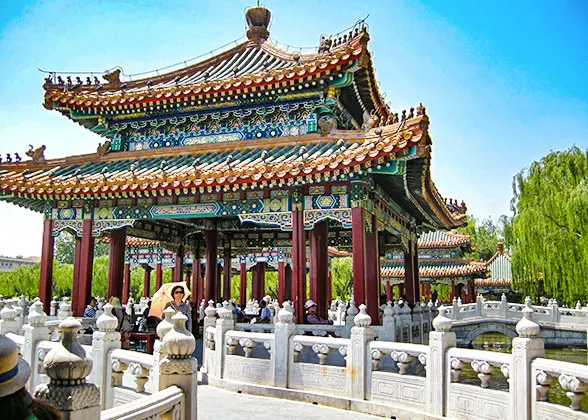 With the Forbidden City and Jingshan Park to its east, Zhong Nan Hai (Central and South Seas) to its south, Beihai (North Sea) Park is one of the oldest, largest and best-preserved ancient imperial gardens in China located in the center of Beijing. This ancient garden, with over 1,000 years' history, is not only a classic combination of the grandiosity of the northern gardens and the refinement of the southern gardens in China, but also a perfect integration of magnificent imperial palaces and solemn religious constructions.
With the Forbidden City and Jingshan Park to its east, Zhong Nan Hai (Central and South Seas) to its south, Beihai (North Sea) Park is one of the oldest, largest and best-preserved ancient imperial gardens in China located in the center of Beijing. This ancient garden, with over 1,000 years' history, is not only a classic combination of the grandiosity of the northern gardens and the refinement of the southern gardens in China, but also a perfect integration of magnificent imperial palaces and solemn religious constructions.
History of Beihai Park
Beihai Park is said to be built according to a traditional Chinese legend. The story is that once upon a time there were three magic mountains called 'Penglai', 'Yingzhou' and 'Fangzhang' located to the east of Bohai Bay (to the east of China). Gods in those mountains had a kind of herbal medicine which would help humans gain immortality.
Consequently, many emperors in the feudal age of China constantly sought those mountains. For example, Emperor Qin Shihuang, the first emperor of the Qin Dynasty (221 - 206 B.C.), wanted to live an eternal life and had sent people to look for the magic mountains but they failed. Then at his palace, he dug a large pool and piled up three earth hills in it to imitate the circumstances described in the legend. Emperor Wudi, the fifth emperor of the Western Han Dynasty (202 B.C. - 8 A.D.) did similar things.
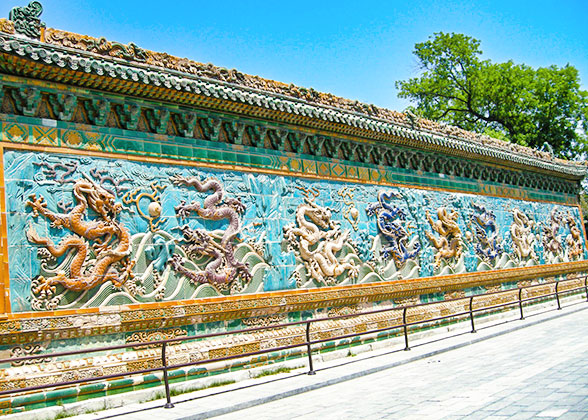 It was believed that different mountain-water combinations in ancient Chinese architecture led to totally different effects. So from then on, almost every emperor during the succeeding dynasties would build a royal garden with one-pool-with-three-hills' layout as a fairyland near his palace. Beihai Park was surely built after this traditional style: the water of Beihai (North Sea) with Zhong Nan Hai (Central and South Seas) is the Taiye Pool; the Jade Flowery (Qionghua) Islet, the island of the Circular City and the Xishantai Island represent the three magic mountains.
It was believed that different mountain-water combinations in ancient Chinese architecture led to totally different effects. So from then on, almost every emperor during the succeeding dynasties would build a royal garden with one-pool-with-three-hills' layout as a fairyland near his palace. Beihai Park was surely built after this traditional style: the water of Beihai (North Sea) with Zhong Nan Hai (Central and South Seas) is the Taiye Pool; the Jade Flowery (Qionghua) Islet, the island of the Circular City and the Xishantai Island represent the three magic mountains.
Actually, Beihai Park was initially built in the Liao Dynasty (916 - 1125) and was repaired and rebuilt in the following dynasties including Jin, Yuan, Ming and Qing (1115 - 1911). The large-scale rebuilding in the reign of Emperor Qianlong of the Qing Dynasty (1644 - 1911) generally established the present scale and pattern of Beihai Park. In 1925, the park was first opened to the public, attracting hundreds of thousands of visitors from all over the world every year.
Touring Beihai Park
Beihai Park covers an area of about 0.71 sq km (about 0.27 sq miles), more than half of which is taken up by the lake. In the middle of the lake and on the central axis of the whole park lies the Jade Flowery Islet, topped by the imposing White Dagoba which is the landmark of Beihai Park. Besides the Jade Flowery Islet, the park has four main scenic areas: the Eastern Shore Area, the Northern Shore Area, the Botanical Garden and the Circular City near the north gate. There are many famous and beautiful places you should not miss when touring Beihai Park.
White Dagoba
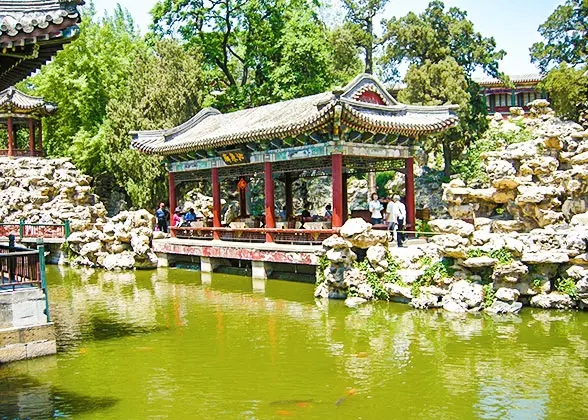 On top of the Jade Flowery Islet, the White Dagoba was built in 1651 on the former site of the Palace in the Moon where Kublai Khan received Marco Polo. At the suggestion of a famous Tibetan lama, Emperor Shunzhi, the first emperor of the Qing Dynasty agreed to build such a Tibetan dagoba to show his belief in Buddhism and his desire for the unification among various Chinese ethnic groups. The White Dagoba was destroyed in an earthquake and reconstructed twice. Now, resting on a huge stone base, it stands 35.9 meters (about 118 feet) high and is capped by two bronze umbrella-like canopies, with 14 bronze bells hanging around them. Inside, the dagoba holds the Buddhist Scriptures, the monk's mantle and alms bowl and two pieces of Sarira. Since the White Dagoba is the highest point in Beihai Park, it served as a vantage point with a beautiful view of the whole park.
On top of the Jade Flowery Islet, the White Dagoba was built in 1651 on the former site of the Palace in the Moon where Kublai Khan received Marco Polo. At the suggestion of a famous Tibetan lama, Emperor Shunzhi, the first emperor of the Qing Dynasty agreed to build such a Tibetan dagoba to show his belief in Buddhism and his desire for the unification among various Chinese ethnic groups. The White Dagoba was destroyed in an earthquake and reconstructed twice. Now, resting on a huge stone base, it stands 35.9 meters (about 118 feet) high and is capped by two bronze umbrella-like canopies, with 14 bronze bells hanging around them. Inside, the dagoba holds the Buddhist Scriptures, the monk's mantle and alms bowl and two pieces of Sarira. Since the White Dagoba is the highest point in Beihai Park, it served as a vantage point with a beautiful view of the whole park.
In front of the White Dagoba is the White Dagoba Temple. There are several other buildings and halls you could visit if you have enough time. These include Zhengjue Hall, the Bell and Drum Towers, the Stone Tablets of 'Qiongdao Chunyin' (means the beautiful scenery of the Jade Flowery Islet in spring; inscribed by Emperor Qianlong of Qing Dynasty) etc, all scattered on the slope of the Qionghua Islet.
Hao Pu Creek (Haopujian) Garden
After touring the Qionghua Islet, you can cross the Zhishan Bridge to the Eastern Shore Scenic Area which has many independent gardens within Beihai Park such as the Painted Boat (Huafang) Studio and the Hao Pu Creek Garden.
Created in 1757, the Hao Pu Creek Garden is one of the best gardens-within-gardens of the existing imperial gardens in China. 'Hao' and 'Pu' were the ancient names of two rivers in Anhui Province. There is a story that goes like this: in the Warring States Period (475 - 221 B.C.), Zhuangzi and Huizi (two famous philosophers of ancient China) argued with each other on the bridge over the Hao River. Zhuangzi said: 'How happy are the fish in the river!' Huizi responded: 'You are not a fish. Then how can you know whether the fish are happy or not?' Zhuangzi answered: 'You are not me. Then how can you know that I don't know the happiness of the fish?' This story inspired Emperor Qianlong to build the Hao Pu Creek Garden to seek happiness and relaxation as free as fish in the river. So the garden is designed for tranquility and happiness, featuring a special mountain-water structure to give the impression of a deep valley which gives seclusion from society.
Quiet Heart (Jingxin) Studio
After visiting the Eastern Shore Area, stepping westward, you will be at the Northern Shore Area. Lying to the east of this area, the Quiet Heart Studio is the most famous independent garden within Beihai Park. It was initially built in Ming Dynasty (1368 - 1644) and enlarged in Qing Dynasty. Inside the studio, there are many magnificent palaces, halls, pavilions, towers, corridors and artificial hills, numerous odd-shaped porous rocks and stones, all artistically arranged. During Qing Dynasty, some of the royal members used to rest or study here.
Nine-Dragon Screen
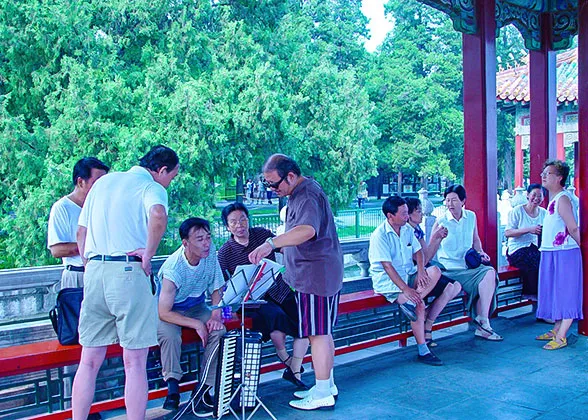 To the northwest lies the well-known Nine-Dragon Screen, which is the only screen having nine huge dragons on both sides among the most famous three Nine-Dragon Screens in China (the other two are respectively in the Forbidden City and Datong, Shanxi Province). Built in 1756, the Nine-Dragon Screen is about 27 meters (about 88.6 feet) long, 6.65 meters (about 21.8 feet) high and 1.42 meters (4.66 feet) thick. It is composed of 424 seven-color glazed tiles that embossing the screen. There are nine huge coiling dragons on each side of the screen and big or small dragons in different postures decorating the two ends and the eaves, making a surprising total of 635 dragons. Even after 200 years, the Nine-Dragon Screen is still bright in color and complete in appearance, showing the high techniques of Chinese arts and crafts in ancient times.
To the northwest lies the well-known Nine-Dragon Screen, which is the only screen having nine huge dragons on both sides among the most famous three Nine-Dragon Screens in China (the other two are respectively in the Forbidden City and Datong, Shanxi Province). Built in 1756, the Nine-Dragon Screen is about 27 meters (about 88.6 feet) long, 6.65 meters (about 21.8 feet) high and 1.42 meters (4.66 feet) thick. It is composed of 424 seven-color glazed tiles that embossing the screen. There are nine huge coiling dragons on each side of the screen and big or small dragons in different postures decorating the two ends and the eaves, making a surprising total of 635 dragons. Even after 200 years, the Nine-Dragon Screen is still bright in color and complete in appearance, showing the high techniques of Chinese arts and crafts in ancient times.
Five-Dragon Pavilions
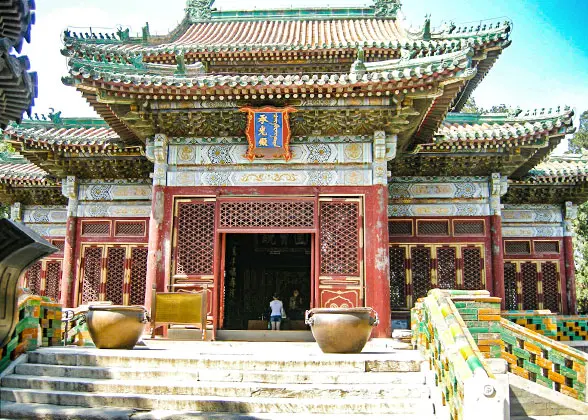 To the southwest of the Nine-Dragon Screen lies the Five-Dragon Pavilions - five connected pavilions with spires and pointed upswept eaves. From a distance, they appear together like a huge dragon. Built first in 1602 and repaired several times in Qing Dynasty, these five pavilions, half over the water, stand on the north bank of the lake opposite the Jade Flowery Islet. There are many exquisite carvings and paintings on the girders and pillars of the pavilions which make the Five-Dragon Pavilions a delightful place for the royal members in ancient China to relax and appreciate the natural beauty.
To the southwest of the Nine-Dragon Screen lies the Five-Dragon Pavilions - five connected pavilions with spires and pointed upswept eaves. From a distance, they appear together like a huge dragon. Built first in 1602 and repaired several times in Qing Dynasty, these five pavilions, half over the water, stand on the north bank of the lake opposite the Jade Flowery Islet. There are many exquisite carvings and paintings on the girders and pillars of the pavilions which make the Five-Dragon Pavilions a delightful place for the royal members in ancient China to relax and appreciate the natural beauty.
You can stand in the Five-Dragon Pavilions to see the Jade Flowery Islet with the gleaming White Dagoba standing in the exuberance of trees, flowers and various other plants. There are also many other worthwhile places to visit around the Five-Dragon Pavilions including the Heavenly King Hall, Chengguan Hall and the Temple of Little Western Skies, a famous Buddhist architecture.
Circular City
Finally you can visit the Circular City right at the southwestern corner of Beihai Park. The city wall stands about 4.6 meters (about 15 feet) high and has a circumference of 276 meters (about 906 feet). Among the various places to visit in the Circular City including halls, towers and pavilions, the most important construction is the Chengguang Hall which holds the extremely precious white jade statue of Buddha introduced from Burma at the end of Qing Dynasty. In front of the hall is a grand urn made of variegated dark jade. With a diameter of 1.5 meters (about 4.9 feet), a circumference of 5 meters (about 16.4 feet), a height of 0.7 meters (about 2.3 feet) and a weighing 3.5 tons, the urn used to be the vessel of Kublai Khan for storing wine.
While visiting these famous and interesting places in Beihai Park, you could have a meal and rest in Fangshan Restaurant located at the northern shore of the lake. This restaurant was started in 1925 by a cook who formerly worked in the Qing court, so the food there is said to be of delicious imperial flavor.
Besides these places of interest in Beihai Park, there are plenty of exhibitions to see. These include the yearly exhibition of water lilies and other water plants in the Botanical Garden, the exhibition of peonies, and varied picture shows, making Beihai Park not only the center of history and culture in Beijing, but also the center of ecological and natural beauty. Now, an ancient but modern Beihai Park welcomes you from all over the world.
 Situated in the western outskirts of Haidian District, the Summer Palace is 15 kilometers (9.3 miles) from central Beijing. Having the largest royal park and being well preserved, it was designated, in 1960 by the State Council, as a Key Cultural Relics Protection Site of China. Containing examples of the ancient arts, it also has graceful landscapes and magnificent constructions. The Summer Palace is the archetypal Chinese garden, and is ranked amongst the most noted and classical gardens of the world. In 1998, it was listed as one of the World Heritage Sites by UNESCO.
Situated in the western outskirts of Haidian District, the Summer Palace is 15 kilometers (9.3 miles) from central Beijing. Having the largest royal park and being well preserved, it was designated, in 1960 by the State Council, as a Key Cultural Relics Protection Site of China. Containing examples of the ancient arts, it also has graceful landscapes and magnificent constructions. The Summer Palace is the archetypal Chinese garden, and is ranked amongst the most noted and classical gardens of the world. In 1998, it was listed as one of the World Heritage Sites by UNESCO. Composed mainly of Longevity Hill and Kunming Lake, The Summer Palace occupies an area of 294 hectares (726.5 acres), three quarters of which is water. Guided by nature, artists designed the gardens exquisitely so that visitors would see marvelous views and be amazed by perfect examples of refined craftwork using the finest materials.
Composed mainly of Longevity Hill and Kunming Lake, The Summer Palace occupies an area of 294 hectares (726.5 acres), three quarters of which is water. Guided by nature, artists designed the gardens exquisitely so that visitors would see marvelous views and be amazed by perfect examples of refined craftwork using the finest materials.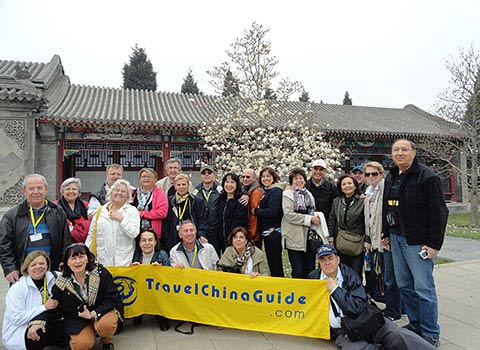 Rear-Hill and Back-Lake Area: although the constructions are fewer here, it has a unique landscape, with dense green trees, and winding paths. Visitors can feel a rare tranquility, and elegance. This area includes scenic spots such as Garden of Harmonious Interest and Suzhou Market Street.
Rear-Hill and Back-Lake Area: although the constructions are fewer here, it has a unique landscape, with dense green trees, and winding paths. Visitors can feel a rare tranquility, and elegance. This area includes scenic spots such as Garden of Harmonious Interest and Suzhou Market Street..jpg)
 With the Forbidden City and Jingshan Park to its east, Zhong Nan Hai (Central and South Seas) to its south, Beihai (North Sea) Park is one of the oldest, largest and best-preserved ancient imperial gardens in China located in the center of Beijing. This ancient garden, with over 1,000 years' history, is not only a classic combination of the grandiosity of the northern gardens and the refinement of the southern gardens in China, but also a perfect integration of magnificent imperial palaces and solemn religious constructions.
With the Forbidden City and Jingshan Park to its east, Zhong Nan Hai (Central and South Seas) to its south, Beihai (North Sea) Park is one of the oldest, largest and best-preserved ancient imperial gardens in China located in the center of Beijing. This ancient garden, with over 1,000 years' history, is not only a classic combination of the grandiosity of the northern gardens and the refinement of the southern gardens in China, but also a perfect integration of magnificent imperial palaces and solemn religious constructions. It was believed that different mountain-water combinations in ancient Chinese architecture led to totally different effects. So from then on, almost every emperor during the succeeding dynasties would build a royal garden with one-pool-with-three-hills' layout as a fairyland near his palace. Beihai Park was surely built after this traditional style: the water of Beihai (North Sea) with Zhong Nan Hai (Central and South Seas) is the Taiye Pool; the Jade Flowery (Qionghua) Islet, the island of the Circular City and the Xishantai Island represent the three magic mountains.
It was believed that different mountain-water combinations in ancient Chinese architecture led to totally different effects. So from then on, almost every emperor during the succeeding dynasties would build a royal garden with one-pool-with-three-hills' layout as a fairyland near his palace. Beihai Park was surely built after this traditional style: the water of Beihai (North Sea) with Zhong Nan Hai (Central and South Seas) is the Taiye Pool; the Jade Flowery (Qionghua) Islet, the island of the Circular City and the Xishantai Island represent the three magic mountains. On top of the Jade Flowery Islet, the White Dagoba was built in 1651 on the former site of the Palace in the Moon where Kublai Khan received Marco Polo. At the suggestion of a famous Tibetan lama, Emperor Shunzhi, the first emperor of the Qing Dynasty agreed to build such a Tibetan dagoba to show his belief in Buddhism and his desire for the unification among various Chinese ethnic groups. The White Dagoba was destroyed in an earthquake and reconstructed twice. Now, resting on a huge stone base, it stands 35.9 meters (about 118 feet) high and is capped by two bronze umbrella-like canopies, with 14 bronze bells hanging around them. Inside, the dagoba holds the Buddhist Scriptures, the monk's mantle and alms bowl and two pieces of Sarira. Since the White Dagoba is the highest point in Beihai Park, it served as a vantage point with a beautiful view of the whole park.
On top of the Jade Flowery Islet, the White Dagoba was built in 1651 on the former site of the Palace in the Moon where Kublai Khan received Marco Polo. At the suggestion of a famous Tibetan lama, Emperor Shunzhi, the first emperor of the Qing Dynasty agreed to build such a Tibetan dagoba to show his belief in Buddhism and his desire for the unification among various Chinese ethnic groups. The White Dagoba was destroyed in an earthquake and reconstructed twice. Now, resting on a huge stone base, it stands 35.9 meters (about 118 feet) high and is capped by two bronze umbrella-like canopies, with 14 bronze bells hanging around them. Inside, the dagoba holds the Buddhist Scriptures, the monk's mantle and alms bowl and two pieces of Sarira. Since the White Dagoba is the highest point in Beihai Park, it served as a vantage point with a beautiful view of the whole park. To the northwest lies the well-known Nine-Dragon Screen, which is the only screen having nine huge dragons on both sides among the most famous three Nine-Dragon Screens in China (the other two are respectively in the Forbidden City and Datong, Shanxi Province). Built in 1756, the Nine-Dragon Screen is about 27 meters (about 88.6 feet) long, 6.65 meters (about 21.8 feet) high and 1.42 meters (4.66 feet) thick. It is composed of 424 seven-color glazed tiles that embossing the screen. There are nine huge coiling dragons on each side of the screen and big or small dragons in different postures decorating the two ends and the eaves, making a surprising total of 635 dragons. Even after 200 years, the Nine-Dragon Screen is still bright in color and complete in appearance, showing the high techniques of Chinese arts and crafts in ancient times.
To the northwest lies the well-known Nine-Dragon Screen, which is the only screen having nine huge dragons on both sides among the most famous three Nine-Dragon Screens in China (the other two are respectively in the Forbidden City and Datong, Shanxi Province). Built in 1756, the Nine-Dragon Screen is about 27 meters (about 88.6 feet) long, 6.65 meters (about 21.8 feet) high and 1.42 meters (4.66 feet) thick. It is composed of 424 seven-color glazed tiles that embossing the screen. There are nine huge coiling dragons on each side of the screen and big or small dragons in different postures decorating the two ends and the eaves, making a surprising total of 635 dragons. Even after 200 years, the Nine-Dragon Screen is still bright in color and complete in appearance, showing the high techniques of Chinese arts and crafts in ancient times. To the southwest of the Nine-Dragon Screen lies the Five-Dragon Pavilions - five connected pavilions with spires and pointed upswept eaves. From a distance, they appear together like a huge dragon. Built first in 1602 and repaired several times in Qing Dynasty, these five pavilions, half over the water, stand on the north bank of the lake opposite the Jade Flowery Islet. There are many exquisite carvings and paintings on the girders and pillars of the pavilions which make the Five-Dragon Pavilions a delightful place for the royal members in ancient China to relax and appreciate the natural beauty.
To the southwest of the Nine-Dragon Screen lies the Five-Dragon Pavilions - five connected pavilions with spires and pointed upswept eaves. From a distance, they appear together like a huge dragon. Built first in 1602 and repaired several times in Qing Dynasty, these five pavilions, half over the water, stand on the north bank of the lake opposite the Jade Flowery Islet. There are many exquisite carvings and paintings on the girders and pillars of the pavilions which make the Five-Dragon Pavilions a delightful place for the royal members in ancient China to relax and appreciate the natural beauty.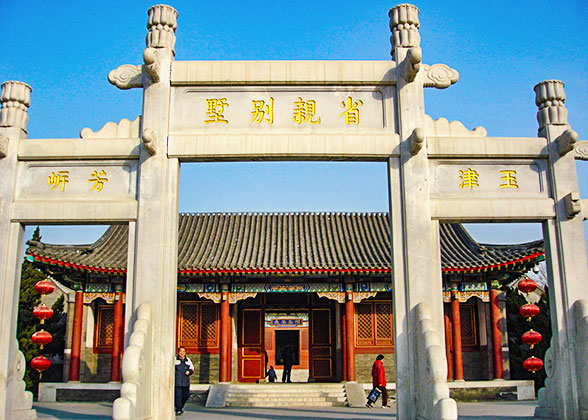 Maybe you are familiar with Dream of the Red Chamber , one of the four ancient Chinese classic masterpieces; if so you will have been impressed by the description of the luxuriant grandeur of the Grand View Garden. This is the garden in which Grandma Liu, a character in the story, becomes dizzy and staggers on seeing it for the first time. Should you not know the story, it won't matter, as you'll be sure to yearn to see the garden for yourself after reading through this introduction.
Maybe you are familiar with Dream of the Red Chamber , one of the four ancient Chinese classic masterpieces; if so you will have been impressed by the description of the luxuriant grandeur of the Grand View Garden. This is the garden in which Grandma Liu, a character in the story, becomes dizzy and staggers on seeing it for the first time. Should you not know the story, it won't matter, as you'll be sure to yearn to see the garden for yourself after reading through this introduction. 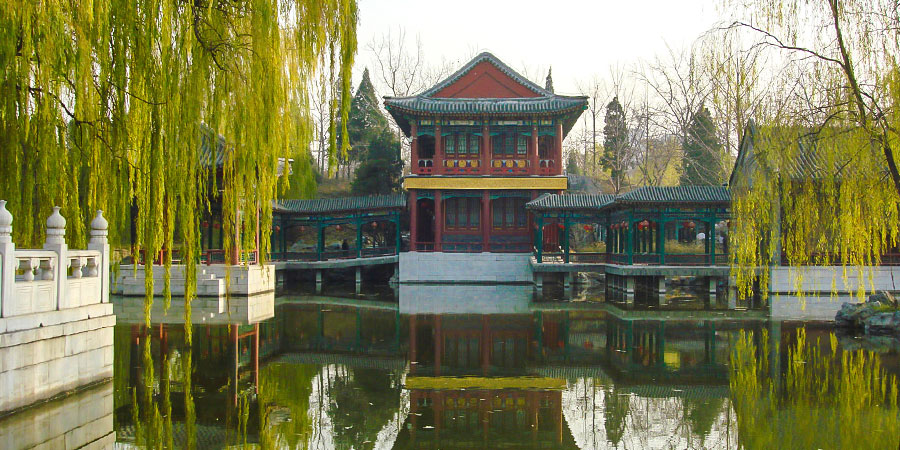 Covering an area of 13 hectares (32.12 acres) with more than 40 scenic spots set within it, the garden has been skillfully designed. It has various classical buildings, such as palaces, pavilions, cloisters, courtyards, water features and rockeries as well as a nunnery. The landscape has delicate hills, peculiar stones, fragrant flowers and exuberant trees where you can hear the sweet singing of birds and the occasional sound of cranes and deer; it is truly an earthly fairyland. Perhaps the most attractive parts are the courtyards which replicate the residences of the main members of the Jia family. These range from the magnificent to the small, the elegant to the simple, and the green to the white, each revealing the personality of the various characters who would have occupied them and enabling you to feel at first hand the ambiance in which the love and political affairs of this medieval family had their being.
Covering an area of 13 hectares (32.12 acres) with more than 40 scenic spots set within it, the garden has been skillfully designed. It has various classical buildings, such as palaces, pavilions, cloisters, courtyards, water features and rockeries as well as a nunnery. The landscape has delicate hills, peculiar stones, fragrant flowers and exuberant trees where you can hear the sweet singing of birds and the occasional sound of cranes and deer; it is truly an earthly fairyland. Perhaps the most attractive parts are the courtyards which replicate the residences of the main members of the Jia family. These range from the magnificent to the small, the elegant to the simple, and the green to the white, each revealing the personality of the various characters who would have occupied them and enabling you to feel at first hand the ambiance in which the love and political affairs of this medieval family had their being. The Grand View Garden is not only perfection to the eyes, but also provides a feast for your appetite. The Grand View Garden Restaurant is an elegant setting for dinner where you can enjoy a delicious meal in an environment that exudes the glories of a past era.
The Grand View Garden is not only perfection to the eyes, but also provides a feast for your appetite. The Grand View Garden Restaurant is an elegant setting for dinner where you can enjoy a delicious meal in an environment that exudes the glories of a past era.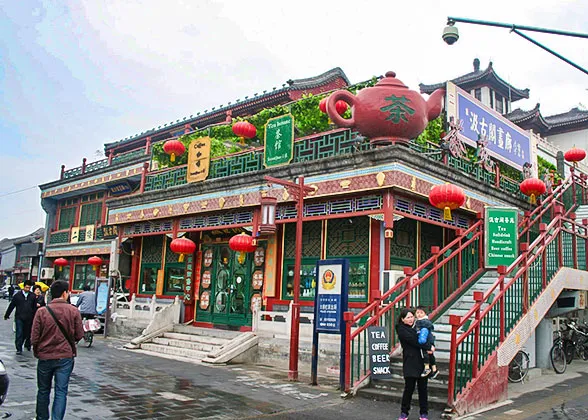 If you have a favor with curios, calligraphy, painting or other artwork in China, Liulichang Street of Chinese Culture is a must when you travel in Beijing.
If you have a favor with curios, calligraphy, painting or other artwork in China, Liulichang Street of Chinese Culture is a must when you travel in Beijing.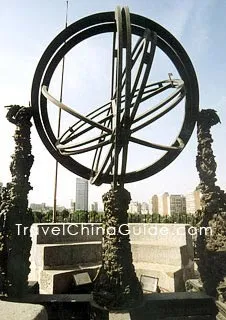
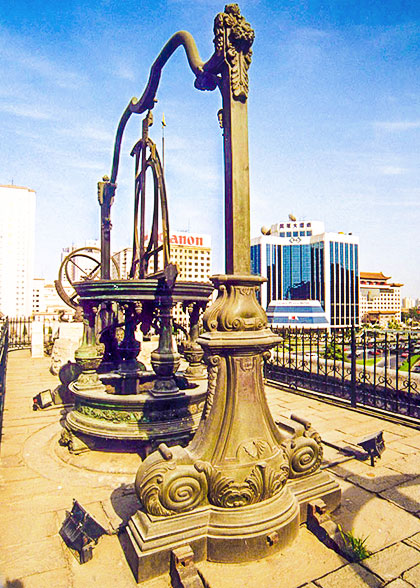
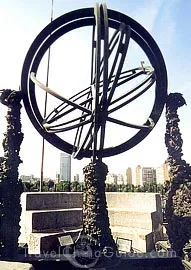
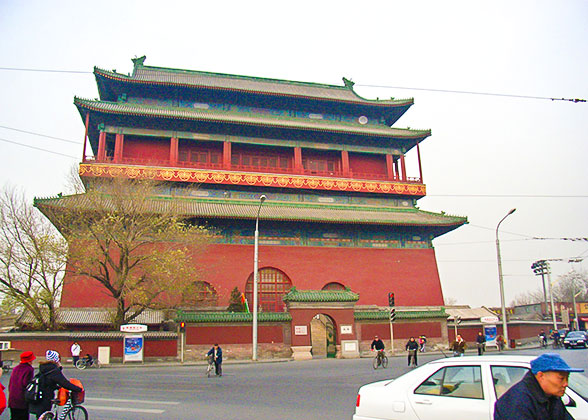 This brick and stone towers have two floors: there is an arched door on all four sides of the tower on the first floor, and you can go up to the second floor through stone stairs. The same exists on the first floor. An arched door was also built on the four sides of the second floor. Additionally, there is a stone window on each side of the four doors. Hanging on an eight-square wooden frame of the second floor, the bell in this tower is the largest and heaviest in China. It is 7.02 meters (23 feet) high including the pendants, with a weight of 63 tons (138,891 pounds). The bell was made of copper, and you can hear its round and clear sound from far away. The two 2-meter-long (2 yards) wooden logs hanging sideward are used to ring the bell.
This brick and stone towers have two floors: there is an arched door on all four sides of the tower on the first floor, and you can go up to the second floor through stone stairs. The same exists on the first floor. An arched door was also built on the four sides of the second floor. Additionally, there is a stone window on each side of the four doors. Hanging on an eight-square wooden frame of the second floor, the bell in this tower is the largest and heaviest in China. It is 7.02 meters (23 feet) high including the pendants, with a weight of 63 tons (138,891 pounds). The bell was made of copper, and you can hear its round and clear sound from far away. The two 2-meter-long (2 yards) wooden logs hanging sideward are used to ring the bell.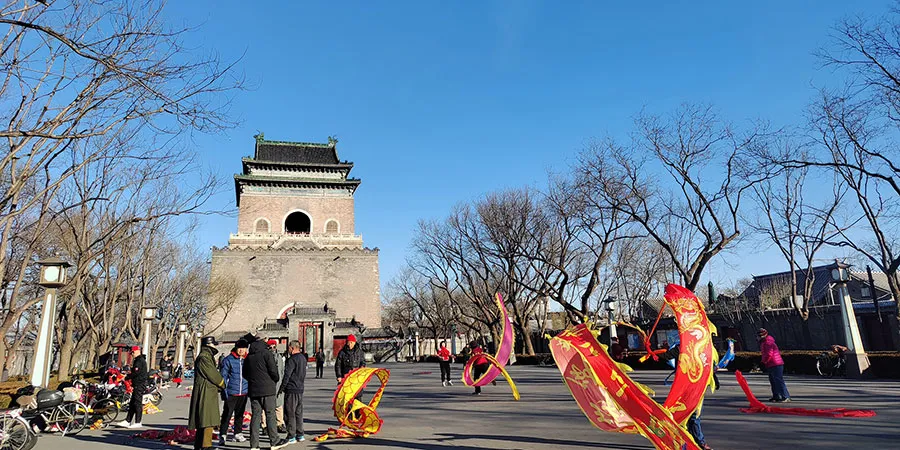 Located 100 meters (109 yards) south to the bell tower, the drum tower was placed on a 4-meter-high (13 feet) stone and brick base. It is 46.7 meters (153 feet) high, a little bit lower than the bell tower that is 47.9 meters high (157 feet). This tower is also a two-storey building; the first floor contains the China Committee for the Promotion of the Minority Art. The second floor contains the exhibition area. Originally, there was one big drum and 24 smaller drums, but only the big drum remains. The method of beating the drum is to beat it quickly for 18 times and then slowly for 18 times. Altogether there are three rounds and 108 tollings. People knock the bell and the drum 108 times, because 108 times represent one year in ancient times.
Located 100 meters (109 yards) south to the bell tower, the drum tower was placed on a 4-meter-high (13 feet) stone and brick base. It is 46.7 meters (153 feet) high, a little bit lower than the bell tower that is 47.9 meters high (157 feet). This tower is also a two-storey building; the first floor contains the China Committee for the Promotion of the Minority Art. The second floor contains the exhibition area. Originally, there was one big drum and 24 smaller drums, but only the big drum remains. The method of beating the drum is to beat it quickly for 18 times and then slowly for 18 times. Altogether there are three rounds and 108 tollings. People knock the bell and the drum 108 times, because 108 times represent one year in ancient times.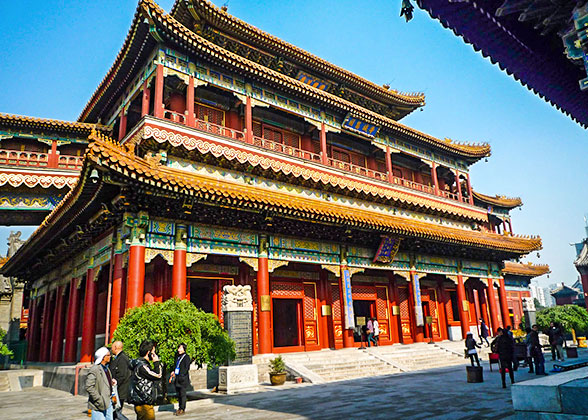 At the northeast corner of Beijing City the traveler will find an elegant and ancient temple known as the Yonghe Lamasery, which is the largest and most perfectly preserved lamasery in present day China.
At the northeast corner of Beijing City the traveler will find an elegant and ancient temple known as the Yonghe Lamasery, which is the largest and most perfectly preserved lamasery in present day China.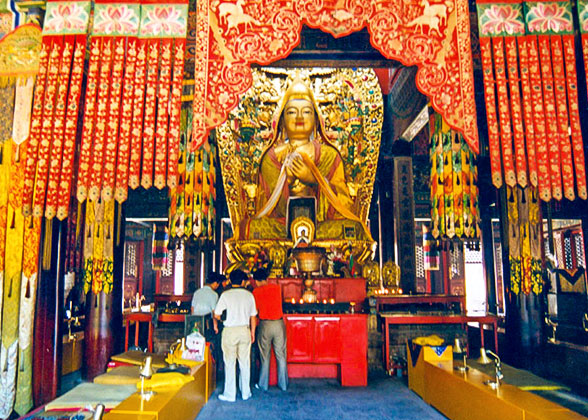 Yonghe Gate, originally the main entrance to the Lamasery is now called Devaraja Hall (Hall of the Heavenly Kings), as there are the statues of four very powerful Heavenly Kings located on both sides of the inner palace walls. The northern Heavenly King on the eastern side holds a snake and treasures; the southern King on the eastern side holds an umbrella and a silver mouse; the southern one on the western side holds a sword and the northern one on the western side holds a Pipa (a musical instrument used in ancient China). Located in the centre of the Palace is a smiling Maitreya.
Yonghe Gate, originally the main entrance to the Lamasery is now called Devaraja Hall (Hall of the Heavenly Kings), as there are the statues of four very powerful Heavenly Kings located on both sides of the inner palace walls. The northern Heavenly King on the eastern side holds a snake and treasures; the southern King on the eastern side holds an umbrella and a silver mouse; the southern one on the western side holds a sword and the northern one on the western side holds a Pipa (a musical instrument used in ancient China). Located in the centre of the Palace is a smiling Maitreya.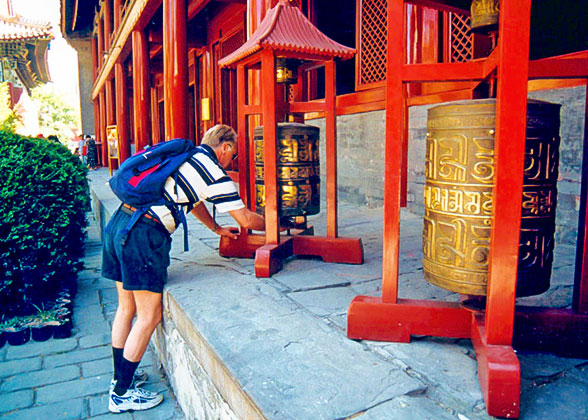 From Yongyoudian continue north to the Falundian (Hall of the Wheel of the Law), which is the location for Lamas reading scriptures and holding Buddhist ceremonies. The Falundian comprises very special features as its structure contains the architectural styles of both Tibetan and Han Nationalities. It was formerly the dwelling of the Emperor's wives. A large statue of Tsong Kha-pa, an ancestor of Lamaism is displayed here in the centre of the Hall and also receives sacrificial offerings. Behind this statue is an Arhat Hill containing 500 Arhats made of five kinds of metals--gold, silver, copper, iron and tin. These Arhats have been shaped in different poses. In front of this Hill is a wooden basin which was said to have been used for washing the body of Emperor Qianlong three days after his birth. Elegant large frescos illustrating the life of Sakyamuni stretch around both the east and west walls.
From Yongyoudian continue north to the Falundian (Hall of the Wheel of the Law), which is the location for Lamas reading scriptures and holding Buddhist ceremonies. The Falundian comprises very special features as its structure contains the architectural styles of both Tibetan and Han Nationalities. It was formerly the dwelling of the Emperor's wives. A large statue of Tsong Kha-pa, an ancestor of Lamaism is displayed here in the centre of the Hall and also receives sacrificial offerings. Behind this statue is an Arhat Hill containing 500 Arhats made of five kinds of metals--gold, silver, copper, iron and tin. These Arhats have been shaped in different poses. In front of this Hill is a wooden basin which was said to have been used for washing the body of Emperor Qianlong three days after his birth. Elegant large frescos illustrating the life of Sakyamuni stretch around both the east and west walls.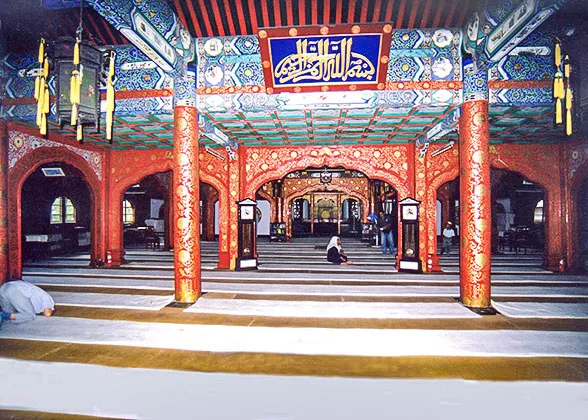 Beijing's most historical and majestic mosque, The Niujie (Ox Street), is situated on Niujie Street in the city's Xuanwu District. First built back in 996, the mosque has a history that stretches back over a thousand years, in which time it has undergone numerous refits and extensions, and has greeted Muslims from all over the world to worship. The mosque covers an area of over 6000 square meters (7176 square yards), and is structurally based on traditional Chinese wooden palaces, yet adopts a typical Arabic-style of decoration. There are no human or animal figures among these decorations as these are considered taboo in Islam.
Beijing's most historical and majestic mosque, The Niujie (Ox Street), is situated on Niujie Street in the city's Xuanwu District. First built back in 996, the mosque has a history that stretches back over a thousand years, in which time it has undergone numerous refits and extensions, and has greeted Muslims from all over the world to worship. The mosque covers an area of over 6000 square meters (7176 square yards), and is structurally based on traditional Chinese wooden palaces, yet adopts a typical Arabic-style of decoration. There are no human or animal figures among these decorations as these are considered taboo in Islam. Walking along the path that runs beside the tower, visitors eventually reach the Prayer Hall - the most important building in the mosque. It is a place only open to Muslims. Covering an area of 600 square meters (718 square yards), the hall has the capacity for a few thousand worshippers. The hall's arched gate is decorated with script from the Koran and poems of worship. Some of the text is written in the ancient Arabic characters of Al-Kufi, which is rarely seen in China. The room is also adorned with various paintings of flowers, strings of glass beads and colored glass, which contribute to the hall's air of great importance and holiness.
Walking along the path that runs beside the tower, visitors eventually reach the Prayer Hall - the most important building in the mosque. It is a place only open to Muslims. Covering an area of 600 square meters (718 square yards), the hall has the capacity for a few thousand worshippers. The hall's arched gate is decorated with script from the Koran and poems of worship. Some of the text is written in the ancient Arabic characters of Al-Kufi, which is rarely seen in China. The room is also adorned with various paintings of flowers, strings of glass beads and colored glass, which contribute to the hall's air of great importance and holiness.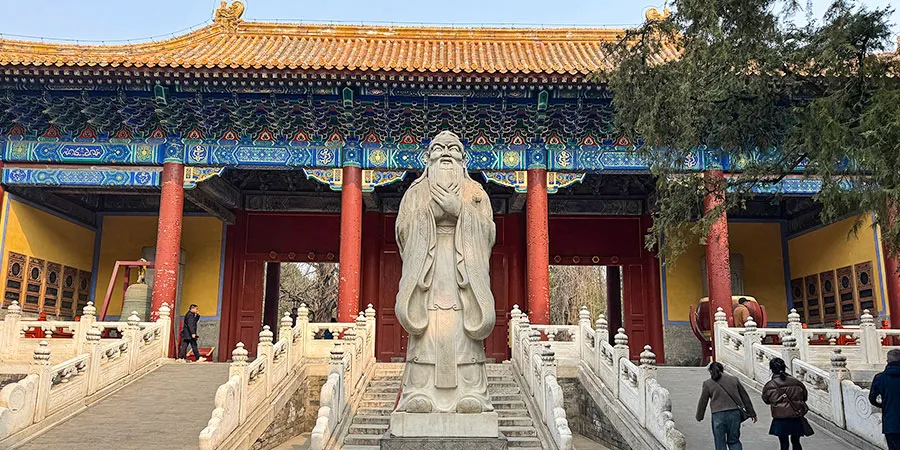 Located on Guozijian Street inside Anding Gate, the Temple of Confucius in Beijing is the place where people paid homage to Confucius during the Yuan Dynasty (1271-1368), Ming Dynasty (1368-1644) and Qing Dynasty (1644-1911). Now the temple houses the Beijing Capital Museum.
Located on Guozijian Street inside Anding Gate, the Temple of Confucius in Beijing is the place where people paid homage to Confucius during the Yuan Dynasty (1271-1368), Ming Dynasty (1368-1644) and Qing Dynasty (1644-1911). Now the temple houses the Beijing Capital Museum.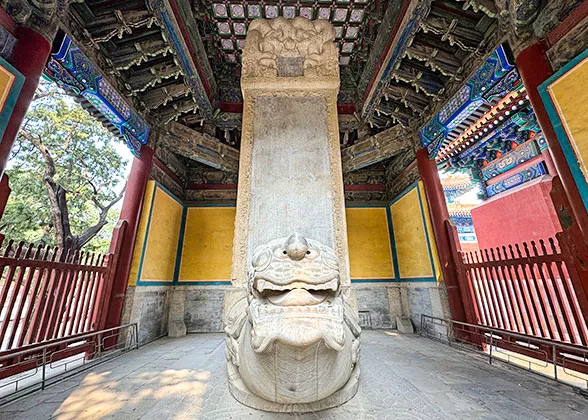 One item of note is the 700-year-old Chujian Bai (Touch Evil Cypress) in the temple. Its name is associated with an ancient legend. During the Ming Dynasty, one day the superior official-Yan Song came to worship Confucius on behalf of the emperor. When he was passing by the cypress, one of the branches of the tree took his hat off. Since Yan Song was a treacherous official, people have thought the old tree could distinguish between good and evil people. Hence its name.
One item of note is the 700-year-old Chujian Bai (Touch Evil Cypress) in the temple. Its name is associated with an ancient legend. During the Ming Dynasty, one day the superior official-Yan Song came to worship Confucius on behalf of the emperor. When he was passing by the cypress, one of the branches of the tree took his hat off. Since Yan Song was a treacherous official, people have thought the old tree could distinguish between good and evil people. Hence its name. The Temple of Heaven is a worthwhile visiting place in Beijing. It is much bigger than the Forbidden City and smaller than the Summer Palace with an area of about 2,700,000 square meters. The Temple was built in 1420 A.D. during the Ming Dynasty to offer sacrifice to Heaven. As Chinese emperors called themselves 'The Son of Heaven' ,they dared not to build their own dwelling,'Forbidden City' bigger than a dwelling for Heaven.
The Temple of Heaven is a worthwhile visiting place in Beijing. It is much bigger than the Forbidden City and smaller than the Summer Palace with an area of about 2,700,000 square meters. The Temple was built in 1420 A.D. during the Ming Dynasty to offer sacrifice to Heaven. As Chinese emperors called themselves 'The Son of Heaven' ,they dared not to build their own dwelling,'Forbidden City' bigger than a dwelling for Heaven.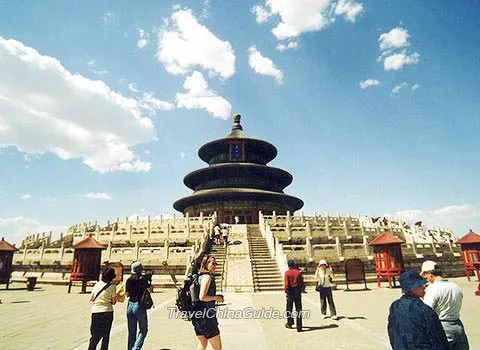 The Circular Altar has three layered terraces with white marble. During the Ming and Qing Dynasties (1368 A.D. - 1911 A.D.), the emperors would offer sacrifice to Heaven on the day of the Winter Solstice every year. This ceremony was to thank Heaven and hope everything would be good in the future. The Hall of Prayer for Good Harvest is a big palace with round roof and three layers of eaves. Inside the Hall are 28 huge posts. The four posts along the inner circle represent four seasons-spring, summer, autumn and winter; the 12 posts along the middle circle represent the 12 months; and 12 posts along the outer circle represent 12 Shichen (Shichen is a means of counting time in ancient China. One Shichen in the past equaled two hours and a whole day was divided into 12 Shichens). The roof is covered with black, yellow and green colored glaze representing the heavens, the earth and everything on earth. The Hall has a base named Altar for Grain Prayers which is made of three layers of white marble and has a height of six meters. Another important building in Temple of Heaven is Imperial Vault of Heaven. If you look at it from far away, you will find that the Vault is like a blue umbrella with gold head. The structure of it is like that of Hall of Prayer for Good Harvest, but smaller in size. The structure was made of bricks and timber. The Vault was used to place memorial tablets of Gods. White marble railings surround the vault.
The Circular Altar has three layered terraces with white marble. During the Ming and Qing Dynasties (1368 A.D. - 1911 A.D.), the emperors would offer sacrifice to Heaven on the day of the Winter Solstice every year. This ceremony was to thank Heaven and hope everything would be good in the future. The Hall of Prayer for Good Harvest is a big palace with round roof and three layers of eaves. Inside the Hall are 28 huge posts. The four posts along the inner circle represent four seasons-spring, summer, autumn and winter; the 12 posts along the middle circle represent the 12 months; and 12 posts along the outer circle represent 12 Shichen (Shichen is a means of counting time in ancient China. One Shichen in the past equaled two hours and a whole day was divided into 12 Shichens). The roof is covered with black, yellow and green colored glaze representing the heavens, the earth and everything on earth. The Hall has a base named Altar for Grain Prayers which is made of three layers of white marble and has a height of six meters. Another important building in Temple of Heaven is Imperial Vault of Heaven. If you look at it from far away, you will find that the Vault is like a blue umbrella with gold head. The structure of it is like that of Hall of Prayer for Good Harvest, but smaller in size. The structure was made of bricks and timber. The Vault was used to place memorial tablets of Gods. White marble railings surround the vault.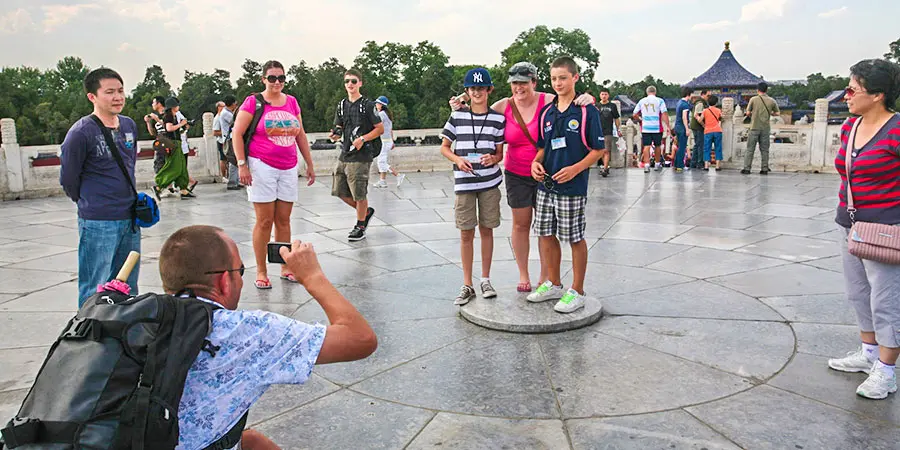 Three Echo Stones is outside of the gate of the Imperial Vault of Heaven. If you speak facing the Vault while standing on the first stone, you will hear one echo; standing on the second and then the third stone, you will hear two and three echoes respectively.
Three Echo Stones is outside of the gate of the Imperial Vault of Heaven. If you speak facing the Vault while standing on the first stone, you will hear one echo; standing on the second and then the third stone, you will hear two and three echoes respectively.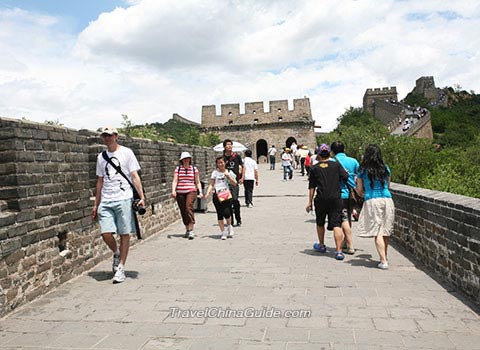 The
The  The Great wall originally functioned as a fortification. As early as the
The Great wall originally functioned as a fortification. As early as the 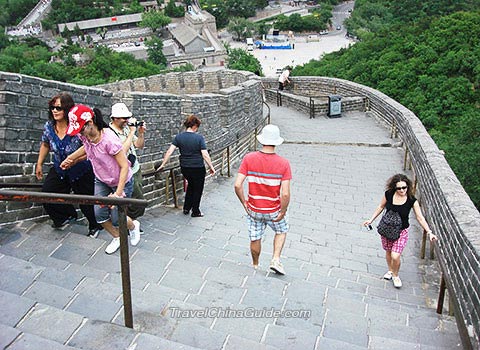 As a landmark erected at the top of a group of mountain ranges, Badaling Great Wall has also witnessed many significant historic events. The first emperor of the Qin Dynasty toured there, Yuan Taizu, the first emperor of
As a landmark erected at the top of a group of mountain ranges, Badaling Great Wall has also witnessed many significant historic events. The first emperor of the Qin Dynasty toured there, Yuan Taizu, the first emperor of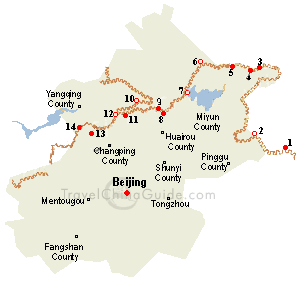
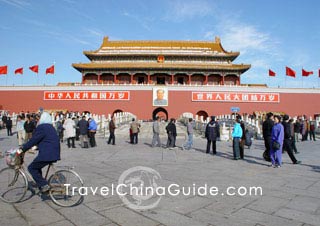 Located at the center of Beijing City is Tiananmen Square, where you can visit Tiananmen Tower, Monument to the People's Heroes, Great Hall of the People, Mao Zedong Memorial Hall and see the national flag raising ceremony. Thousands of people come to the Square every day. It is the must place to visit in Beijing City.
Located at the center of Beijing City is Tiananmen Square, where you can visit Tiananmen Tower, Monument to the People's Heroes, Great Hall of the People, Mao Zedong Memorial Hall and see the national flag raising ceremony. Thousands of people come to the Square every day. It is the must place to visit in Beijing City.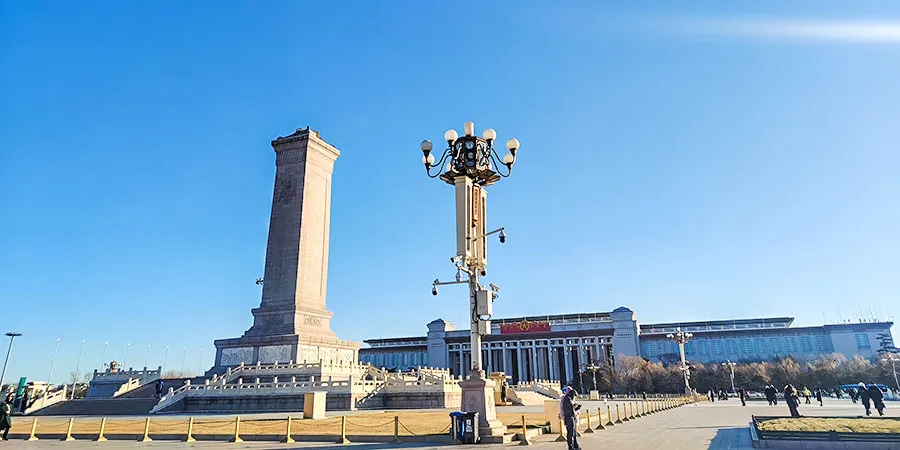 The granite Monument to the People's Heroes is just at the center of the Tiananmen Square. Built in 1952, it is the largest monument in China's history. ' The People's Heroes are Immortal' written by Chairman Mao is engraved on the monument. Eight unusually large relief sculptures show to the people the development of Chinese modern history. Two rows of white marble railings enclose the monument, simple and beautiful.
The granite Monument to the People's Heroes is just at the center of the Tiananmen Square. Built in 1952, it is the largest monument in China's history. ' The People's Heroes are Immortal' written by Chairman Mao is engraved on the monument. Eight unusually large relief sculptures show to the people the development of Chinese modern history. Two rows of white marble railings enclose the monument, simple and beautiful.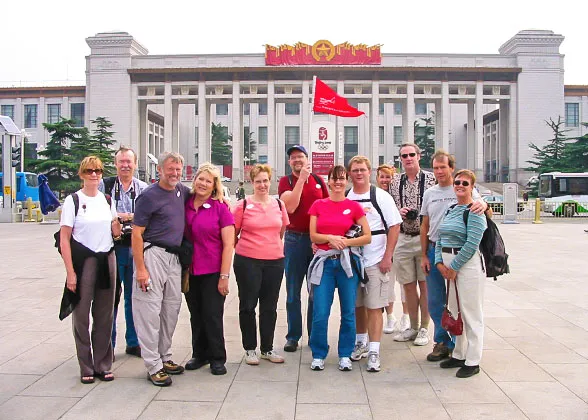 Mao Zedong Memorial Hall is at the south side of the Square. This Hall is divided into three halls and our dear Chairman Mao's body lies in a crystal coffin in one of the halls surrounded by fresh bouquets of various famous flowers and grasses.
Mao Zedong Memorial Hall is at the south side of the Square. This Hall is divided into three halls and our dear Chairman Mao's body lies in a crystal coffin in one of the halls surrounded by fresh bouquets of various famous flowers and grasses.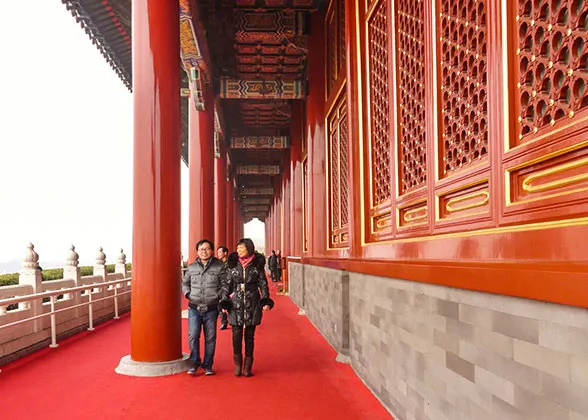 Five Star Red Flag-the Chinese national flag, flies high in the sky above the Square. To see the guard of honor raise the Flag is a must for the tourist visiting Beijing City. You have to get up very early and arrive at the Square before sunrise. Only by doing so can you see the ceremony clearly as there are crowds of people attending the ceremony every day.
Five Star Red Flag-the Chinese national flag, flies high in the sky above the Square. To see the guard of honor raise the Flag is a must for the tourist visiting Beijing City. You have to get up very early and arrive at the Square before sunrise. Only by doing so can you see the ceremony clearly as there are crowds of people attending the ceremony every day.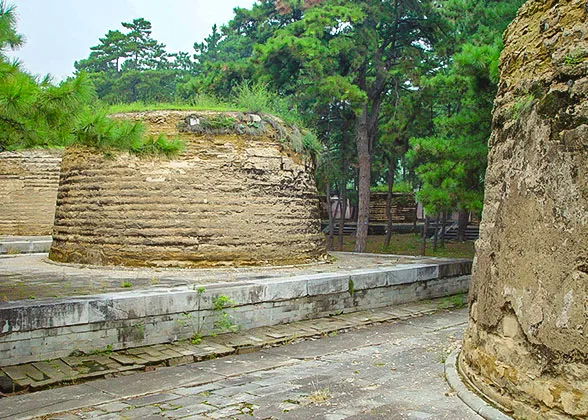 The Eastern Qing Tombs, a sacred burial ground near Beijing, is one of the two tomb areas devoted to the emperors, empresses and imperial concubines of the Qing Dynasty (1644-1911, the last feudal empire in China).The other is the
The Eastern Qing Tombs, a sacred burial ground near Beijing, is one of the two tomb areas devoted to the emperors, empresses and imperial concubines of the Qing Dynasty (1644-1911, the last feudal empire in China).The other is the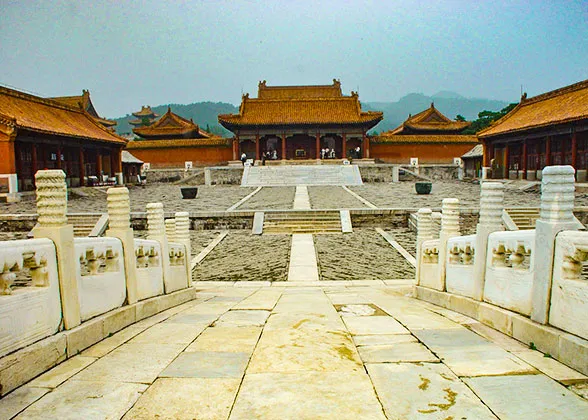 Of all the tombs, Xiaoling is the biggest and most elaborate, standing as the focal point of the entire structure. The grandeur of this tomb may be attributed to its having been the first sepulcher constructed for a member of the royal family of the Qing Dynasty, so the builders hoped to set the tone for a prosperous future. Crossing through the Great Red Gate, you can see buildings of different sizes, all with roofs of yellow glazed tile, connected by the brick paths or 'sacred ways' that converge in the area of Xiaoling.
Of all the tombs, Xiaoling is the biggest and most elaborate, standing as the focal point of the entire structure. The grandeur of this tomb may be attributed to its having been the first sepulcher constructed for a member of the royal family of the Qing Dynasty, so the builders hoped to set the tone for a prosperous future. Crossing through the Great Red Gate, you can see buildings of different sizes, all with roofs of yellow glazed tile, connected by the brick paths or 'sacred ways' that converge in the area of Xiaoling.

